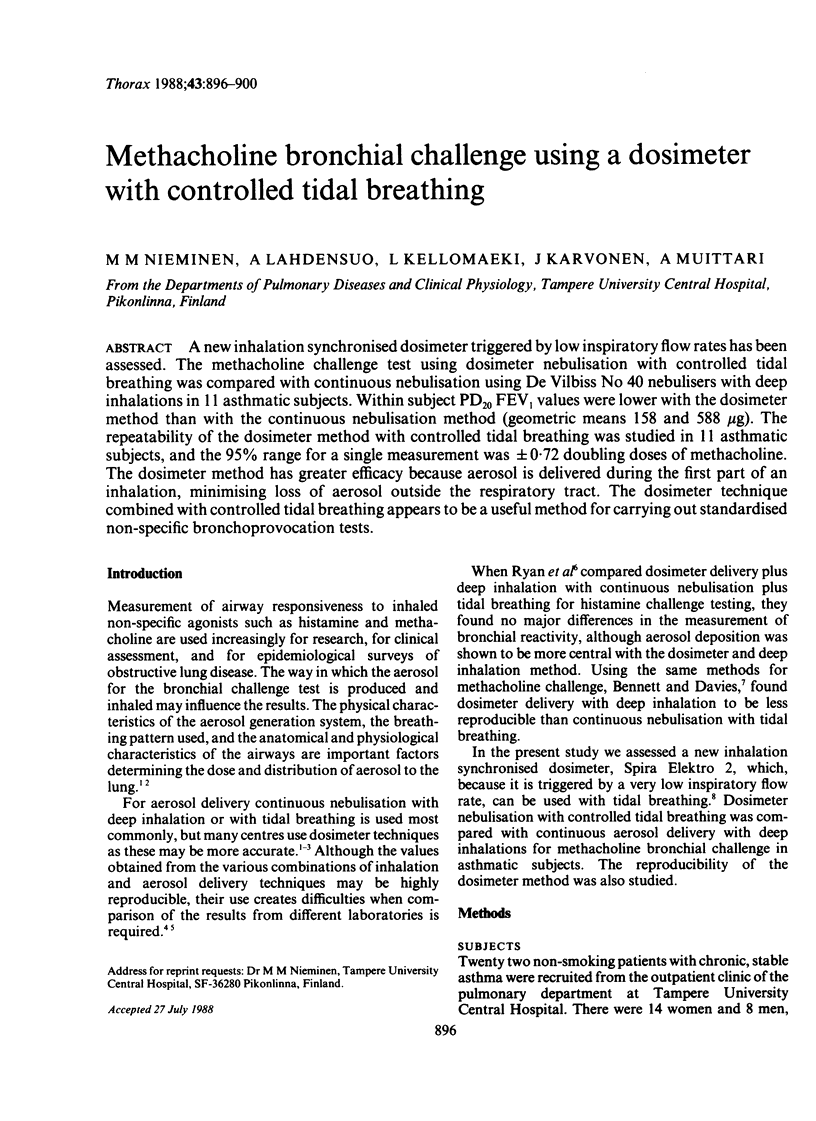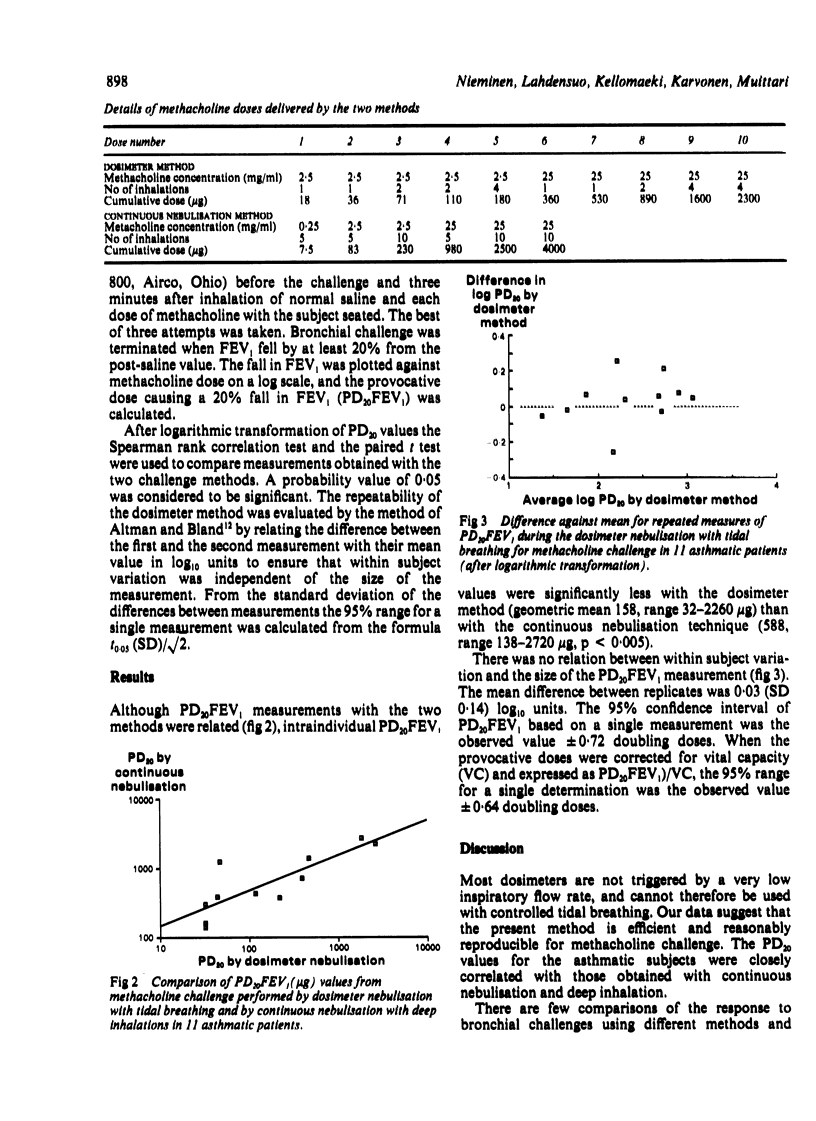Abstract
A new inhalation synchronised dosimeter triggered by low inspiratory flow rates has been assessed. The methacholine challenge test using dosimeter nebulisation with controlled tidal breathing was compared with continuous nebulisation using De Vilbiss No 40 nebulisers with deep inhalations in 11 asthmatic subjects. Within subject PD20 FEV1 values were lower with the dosimeter method than with the continuous nebulisation method (geometric means 158 and 588 micrograms). The repeatability of the dosimeter method with controlled tidal breathing was studied in 11 asthmatic subjects, and the 95% range for a single measurement was +/- 0.72 doubling doses of methacholine. The dosimeter method has greater efficacy because aerosol is delivered during the first part of an inhalation, minimising loss of aerosol outside the respiratory tract. The dosimeter technique combined with controlled tidal breathing appears to be a useful method for carrying out standardised non-specific bronchoprovocation tests.
Full text
PDF




Images in this article
Selected References
These references are in PubMed. This may not be the complete list of references from this article.
- Beaupré A., Malo J. L. Comparison of histamine bronchial challenges with the Wright nebulizer and the dosimeter. Clin Allergy. 1979 Nov;9(6):575–583. doi: 10.1111/j.1365-2222.1979.tb00482.x. [DOI] [PubMed] [Google Scholar]
- Beaupré A., Malo J. L. Histamine dose-response curves in asthma: relevance of the distinction between PC20 and reactivity in characterising clinical state. Thorax. 1981 Oct;36(10):731–736. doi: 10.1136/thx.36.10.731. [DOI] [PMC free article] [PubMed] [Google Scholar]
- Bennett J. B., Davies R. J. A comparison of histamine and methacholine bronchial challenges using the DeVilbiss 646 nebulizer and the Rosenthal-French dosimeter. Br J Dis Chest. 1987 Jul;81(3):252–259. doi: 10.1016/0007-0971(87)90158-6. [DOI] [PubMed] [Google Scholar]
- Britton J., Mortagy A., Tattersfield A. Histamine challenge testing: comparison of three methods. Thorax. 1986 Feb;41(2):128–132. doi: 10.1136/thx.41.2.128. [DOI] [PMC free article] [PubMed] [Google Scholar]
- Chai H., Farr R. S., Froehlich L. A., Mathison D. A., McLean J. A., Rosenthal R. R., Sheffer A. L., Spector S. L., Townley R. G. Standardization of bronchial inhalation challenge procedures. J Allergy Clin Immunol. 1975 Oct;56(4):323–327. doi: 10.1016/0091-6749(75)90107-4. [DOI] [PubMed] [Google Scholar]
- Dehaut P., Rachiele A., Martin R. R., Malo J. L. Histamine dose-response curves in asthma: reproducibility and sensitivity of different indices to assess response. Thorax. 1983 Jul;38(7):516–522. doi: 10.1136/thx.38.7.516. [DOI] [PMC free article] [PubMed] [Google Scholar]
- Felarca A. B., Itkin I. H. Studies with the quantitative-inhalation challenge technique. I. Curve of dose response to acetyl-beta-methylcholine in patients with asthma of known and unknown origin, hay fever subjects, and nonatopic volunteers. J Allergy. 1966 Apr;37(4):223–235. doi: 10.1016/0021-8707(66)90117-1. [DOI] [PubMed] [Google Scholar]
- Guidelines for standardization of bronchial challenges with (nonspecific) bronchoconstricting agents. Bull Eur Physiopathol Respir. 1983 Sep-Oct;19(5):495–514. [PubMed] [Google Scholar]
- Heyder J. Charting human thoracic airways by aerosols. Clin Phys Physiol Meas. 1983 Feb;4(1):29–37. doi: 10.1088/0143-0815/4/1/003. [DOI] [PubMed] [Google Scholar]
- Juniper E. F., Frith P. A., Dunnett C., Cockcroft D. W., Hargreave F. E. Reproducibility and comparison of responses to inhaled histamine and methacholine. Thorax. 1978 Dec;33(6):705–710. doi: 10.1136/thx.33.6.705. [DOI] [PMC free article] [PubMed] [Google Scholar]
- Kradjan W. A., Lakshminarayan S. Efficiency of air compressor-driven nebulizers. Chest. 1985 Apr;87(4):512–516. doi: 10.1378/chest.87.4.512. [DOI] [PubMed] [Google Scholar]
- Lewis R. A., Fleming J. S. Fractional deposition from a jet nebulizer: how it differs from a metered dose inhaler. Br J Dis Chest. 1985 Oct;79(4):361–367. doi: 10.1016/0007-0971(85)90069-5. [DOI] [PubMed] [Google Scholar]
- Madsen F., Frølund L., Nielsen N. H., Svendsen U. G., Weeke B. Bronchial challenge: ventilation during 'tidal volume breathing' inhalation is not constant. Bull Eur Physiopathol Respir. 1986 Nov-Dec;22(6):517–522. [PubMed] [Google Scholar]
- Madsen F., Frølund L., Nielsen N. H., Svendsen U. G., Weeke B. Fixed ventilation during tidal volume breathing bronchial challenge may improve repeatability. Allergy. 1987 Oct;42(7):535–540. doi: 10.1111/j.1398-9995.1987.tb00378.x. [DOI] [PubMed] [Google Scholar]
- Muittari A. The value of the metacholine test as a diagnostic method in bronchospastic disorders. Ann Med Intern Fenn. 1968;57(4):197–203. [PubMed] [Google Scholar]
- Nieminen M. M., Holli H., Lahdensuo A., Muittari A., Karvonen J. Aerosol deposition in automatic dosimeter nebulization. Eur J Respir Dis. 1987 Sep;71(3):145–152. [PubMed] [Google Scholar]
- Pavia D., Thomson M. L., Clarke S. W., Shannon H. S. Effect of lung function and mode of inhalation on penetration of aerosol into the human lung. Thorax. 1977 Apr;32(2):194–197. doi: 10.1136/thx.32.2.194. [DOI] [PMC free article] [PubMed] [Google Scholar]
- Ryan G., Dolovich M. B., Obminski G., Cockcroft D. W., Juniper E., Hargreave F. E., Newhouse M. T. Standardization of inhalation provocation tests: influence of nebulizer output, particle size, and method of inhalation. J Allergy Clin Immunol. 1981 Feb;67(2):156–161. doi: 10.1016/0091-6749(81)90012-9. [DOI] [PubMed] [Google Scholar]



